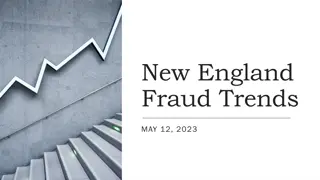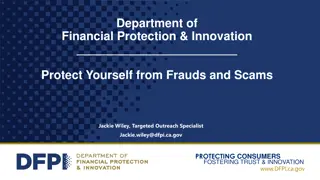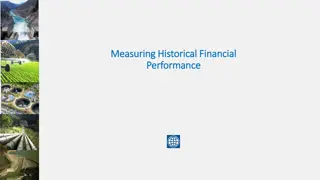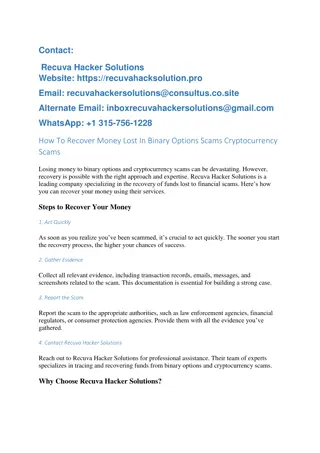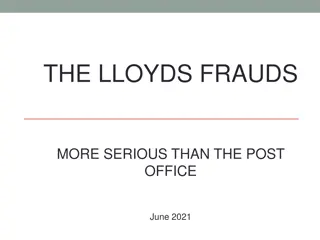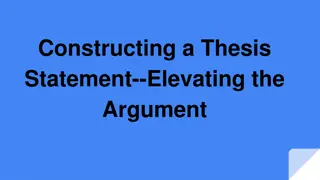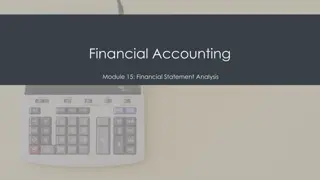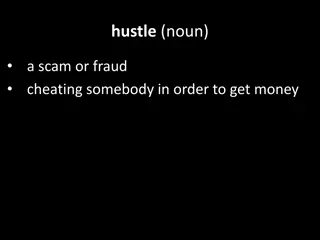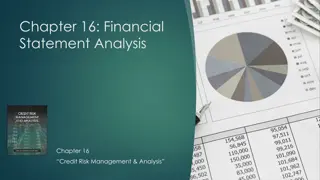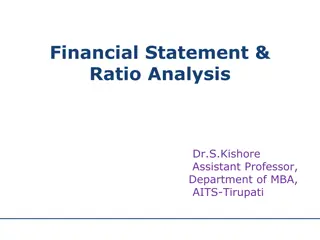Understanding Financial Statement Frauds
Financial statement fraud involves deliberate misstatements or omissions to deceive investors and creditors, leading to significant financial losses and undermining trust in the auditing profession. This type of fraud can have far-reaching effects on economic growth, regulatory intervention, and public confidence.
Download Presentation

Please find below an Image/Link to download the presentation.
The content on the website is provided AS IS for your information and personal use only. It may not be sold, licensed, or shared on other websites without obtaining consent from the author.If you encounter any issues during the download, it is possible that the publisher has removed the file from their server.
You are allowed to download the files provided on this website for personal or commercial use, subject to the condition that they are used lawfully. All files are the property of their respective owners.
The content on the website is provided AS IS for your information and personal use only. It may not be sold, licensed, or shared on other websites without obtaining consent from the author.
E N D
Presentation Transcript
1 FRAUDS IN FINANCIAL STATEMENT FEBRUARY 2016 DAMANIA & VARAIYA CHARTERED ACCOUNTANTS CA ASHOK DHAKAR HARSHIT SHAH
2 Definition of Financial Statement Fraud Deliberate misstatements or omissions of amounts or disclosures of financial statements to deceive financial particularly investors and creditors. statement users,
3 Some Statistics relating to frauds More than 50% of U.S. corporations are victims of fraud with losses of more than $500,000 (Albrecht & Searcy 2001). Enron lost about $70 billion in market capitalization to investors, employees, and pensioners. Enron, WorldCom, Quest, Global Crossing, and Tyco s loss to shareholders was $460 billion (Cotton 2002). Other fraud costs are legal costs, increased insurance costs, loss of productivity, adverse impacts on employee morale, customers goodwill, suppliers trust, and negative stock market reactions.
4 Effects of Financial Statement Fraud Undermines the reliability, quality, transparency, and integrity of the financial reporting process. Jeopardizes the integrity and objectivity of the auditing profession, especially auditors and auditing firms. Adversely affects the nation s economic growth and prosperity. Results in huge litigation costs.
5 Effects of Financial Statement Fraud Encourages regulatory intervention. Raises serious doubt about the efficacy of financial statement audits . Causes bankruptcy or substantial economic losses by the company engaged in financial statement fraud. Erodes public confidence and trust in the accounting and auditing profession.
6 Who Commits Financial Statement Fraud? Senior management Mid and lower level employees Organized criminals
7 Types of frauds Types of Frauds Victim Preparator Employee embezzlement or Occupational fraud Management Fraud Employers Employees Stockholders, Lenders and who rely on FS Investors Top Management Investment Scams Individuals Vendor Fraud Organizations that buy Goods or Services Organizations that Sell Goods or Services Organizations or Individuals that Sell Goods or Services Customers Customer Fraud
8 Why Do People Commit Financial Statement Frauds? I need to hit my monthly targets Generally, it is noted that frauds like other crime, can be best explained by three factors: a supply of motivated offenders, the availability of suitable targets and the absence of capable guardians- control system or someone to mind the store. Incentive Pressure Fraud Risk Attitude/ rationalism Opportunity Nobody really checks Everyone is Doing it
9 Why Senior Management Will Overstate Business Performance? To meet or exceed the earnings or revenue growth expectations of stock market analysts. To increase the amount of financing available from asset-based loans. To meet a lender s criteria for granting/extending loan facilities. To meet corporate performance criteria set by the parent company. To meet personal performance criteria. To trigger performance-related compensation or earn-out payments.
10 Why Senior Management Will Understate Business Performance? To defer surplus earnings to the next accounting period. To preserve a trend of consistent growth, avoiding volatile results. To take all possible write-offs in one bigbath now so future earnings will be consistently higher. To reduce expectations now so future growth will be better perceived and rewarded.
11 How Do People Commit Financial Statement Frauds? Playing with the accounting system Beating the accounting system Going outside the accounting system
12 Responsibility of Management Company management is responsible for financial statements. Company s board of directors and senior management sets the code of conduct. Company s ethics the standard by which all other employees will tend to conduct themselves .
13 Responsibility of Auditors As per Sec 143(12) of the Companies Act, 2013, if an auditor in course of his audit has reasons to believe that offence involving fraud is being or has been committed against the company by officers or employees of the company, auditor shall immediately report the matter to Central Government within such time and manner as prescribed. If auditor does not comply with the provisions of Sub-section (12), the auditor shall be punishable with fine which shall not be less than one lakh rupees but which may extend to twenty-five lakh rupees.
14 Penalty for Committing Frauds As per Sec 447 of the Companies Act,2013, any person or company who is found to be guilty of fraud, shall be punishable with imprisonment for a term which shall not be less than six months but which may extend to ten years and shall be liable to fine which shall not be less than the amount involved in the fraud. In case of repeated default within a period of three years, the company or person who is in default shall be punishable with twice the amount of fine for such offence in addition to any imprisonment provided for that offence.
15 Users of Financial Statements Transaction Activity Financial Statements Accounting System Bankers Investors Vendors Government Management Information Users Balance Sheet Income Statement Statement of Owner Equity Statement of Cash Flows Loan Approval Financial Investment Credit Approval Operational & Financial Decisions Decisions
16 Methods of Financial Statement Fraud Fictitious revenues Timing differences Improper asset valuations Concealed liabilities and expenses Improper disclosures
17 Sales with conditions Fictitious Revenues Fake or phantom customers Pressure to boost revenues Recording of goods or services that did not occur
18 Fictitious Revenues - Example Sr. No. For example, Company A wishes to record 1,00,000 in fictitious sales to a non-existing customer. 1. Accounts Receivable A/c Dr. To Sales A/c Particulars Amount (Dr.) Amount (Cr.) 1,00,000 1,00,000 2. Fixed asset A/c To Cash A/c Dr. 1,00,000 1,00,000 3 Cash A/c Dr. To Accounts Receivable A/c Thus, the cash and accounts receivable entries cancel each other. That leaves the fictitious fixed assets and revenue, one being an asset and the other profit increase. Since fixed assets and revenues usually are significant amounts, these fictitious amounts will go unnoticed unlike cash and accounts receivable. 1,00,000 1,00,000
19 Timing Differences Shift revenues or expenses between two periods, increasing or decreasing earnings as desired Recording revenues and/or expenses in improper periods
20 Timing Differences - Example Company Fraud Scheme Result Overstated revenue for over 4 years by Co. agreed to pay $10 million in fines and accelerating the recognition of $3 restate its income for the years 1997-2000. billion in revenue and inflating earnings SEC sued three current KPMG partners and Xerox by about $1.5 billion. Alleged scheme one former partner of securities fraud in the included the recognition of revenue on claiming the firm fraudulently let the Co. its office copier leases too early in their manipulate its accounting practices to fill a $3 cycles. billion gap and make it appear to be meeting market expectations.
21 Concealed Liabilities Capitalized Expenses Failure to disclose warranty Costs and Liabilities
22 Concealed Liabilities - Example Company Fraud Scheme Result Misappropriation of firm assets by Declared bankruptcy in January 2002. CEO and Adelphia executives for personal use. family members charged with fraud. Communications Concealment of $2.3 billion in loans to cover losses by founder and family members.
23 Subsequent events Improper Disclosures Management fraud Related party transactions Accounting changes
24 Improper Disclosures - Example Company Fraud Scheme Result Misappropriation of $600 million by CEO and CFO for Three former executives including CEO and personal use through theft and the false sale of securities. general counsel arrested for fraud. Company also separately sued former CEO seeking the CEO also charged with avoiding payment of Tyco return of more than $100 million. Suit alleges CEO gave over $1 million in sales taxes on $13 million International himself unauthorized bonuses totalling $58 million and of artwork unauthorized loans of more than $43 million, and of taking personal credit for more than $43 million in charitable donations that actually were made by Tyco.
25 Improper Asset Valuation Accounts receivable Inventory valuation Business combinations Fixed assets
26 Improper Asset Valuation - Example Company Fraud Scheme Result Intentionally improperly capitalized Declared bankruptcy, July 2002. Former billions of dollars of expenses as capital finance chief and finance and accounting expenditures. executives charged with securities fraud. WorldCom, Inc. Former CEO facing possible charges for allegedly profiting improperly from IPOs offered by brokerages in return for investment banking business.
27 Financial Statement Analysis Analyzes the relationships between the items on an income statement, balance sheet, or statement of cash flows by expressing components as percentages Vertical analysis Analyzes the percentage change in individual financial statement items Horizontal analysis Measures the relationship between amounts of two different financial statements Ratio analysis
28 Deterrence of Financial Statement Frauds 1. Reduce pressures to commit financial statement frauds 2. Reduce the opportunities to commit financial statement frauds 3. Reduce rationalization of financial statement frauds
29 Reduce Pressure to Commit Financial Statement Frauds Establish effective board oversight of the tone at the top created by management. Avoid setting unachievable financial goals. Change goals if changed market conditions calls for it. Discourage excessive external corporate performance. Remove operational obstacles performance. expectations of future blocking effective
30 Reduce the Opportunities to Commit Financial Statement Frauds Maintain accurate and complete internal accounting records. Carefully monitor the business relationships of suppliers, representatives, and others who interface in the transactions between financial units. Establish a physical security system to secure company assets, including finished goods, cash, capital equipment, tools, and other valuable items. Maintain accurate personnel records including background checks on new employees. Encourage strong supervisory and leadership relationships within groups. Establish clear and uniform accounting procedures transactions buyers, and interpersonal agents, purchasing sales
31 Reduce Rationalization of Financial Statement Frauds Promote strong values, based on integrity, throughout the organization. Have policies that clearly define prohibited behavior with respect to accounting and financial statement frauds. Provide regular training to all employees communicating prohibited behavior. The consequences of violating the rules and the punishment of violators should be clearly communicated




